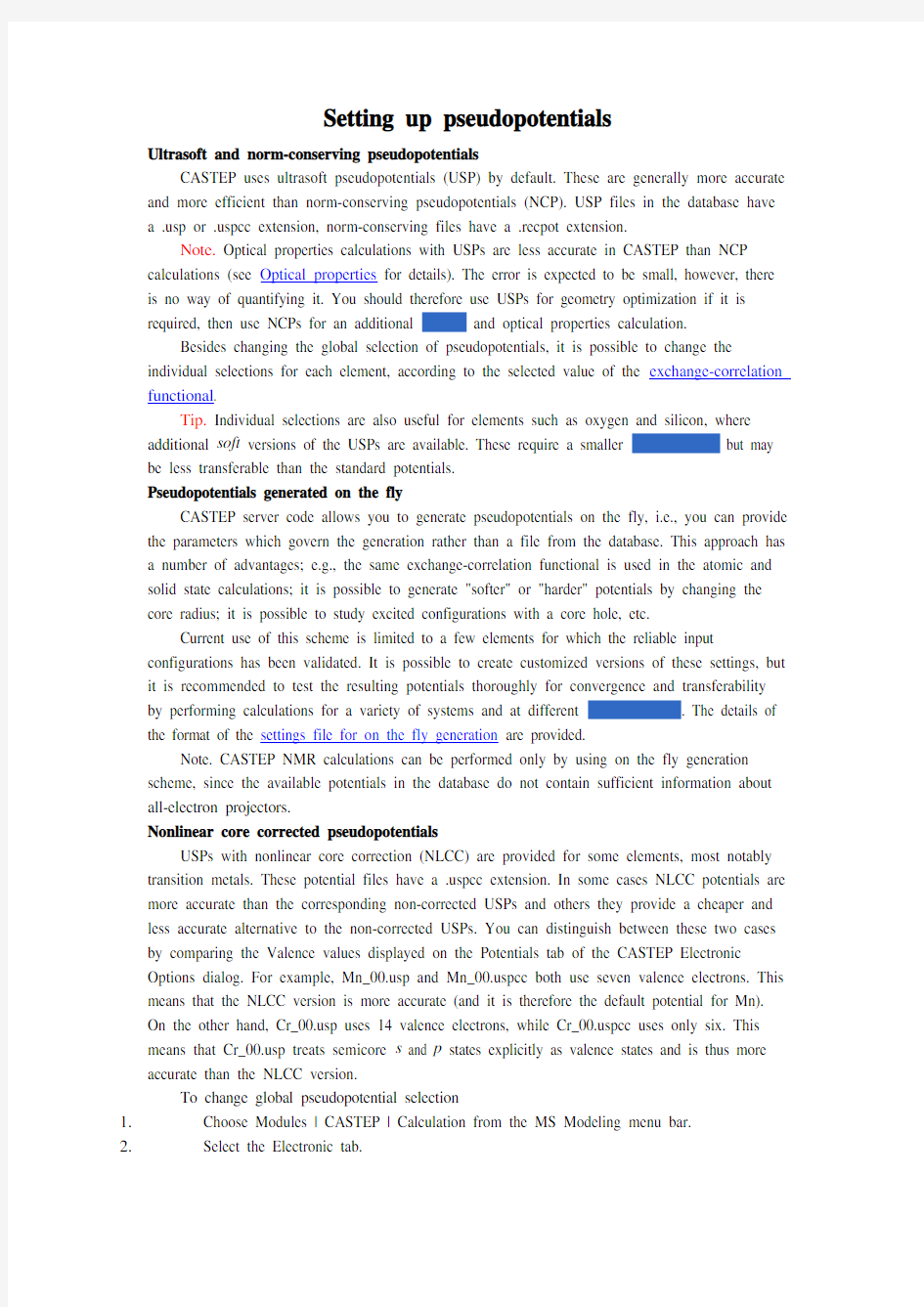Setting up pseudopotentials


Setting up pseudopotentials
Ultrasoft and norm-conserving pseudopotentials
CASTEP uses ultrasoft pseudopotentials (USP) by default. These are generally more accurate and more efficient than norm-conserving pseudopotentials (NCP). USP files in the database have
a .usp or .uspcc extension, norm-conserving files have a .recpot extension.
Note. Optical properties calculations with USPs are less accurate in CASTEP than NCP calculations (see Optical properties for details). The error is expected to be small, however, there is no way of quantifying it. You should therefore use USPs for geometry optimization if it is
required, then use NCPs for an additional energy and optical properties calculation.
Besides changing the global selection of pseudopotentials, it is possible to change the individual selections for each element, according to the selected value of the exchange-correlation functional.
Tip. Individual selections are also useful for elements such as oxygen and silicon, where additional soft versions of the USPs are available. These require a smaller energy cutoff but may be less transferable than the standard potentials.
Pseudopotentials generated on the fly
CASTEP server code allows you to generate pseudopotentials on the fly, i.e., you can provide the parameters which govern the generation rather than a file from the database. This approach has
a number of advantages; e.g., the same exchange-correlation functional is used in the atomic and
solid state calculations; it is possible to generate "softer" or "harder" potentials by changing the core radius; it is possible to study excited configurations with a core hole, etc.
Current use of this scheme is limited to a few elements for which the reliable input configurations has been validated. It is possible to create customized versions of these settings, but it is recommended to test the resulting potentials thoroughly for convergence and transferability by performing calculations for a variety of systems and at different energy cutoffs. The details of the format of the settings file for on the fly generation are provided.
Note. CASTEP NMR calculations can be performed only by using on the fly generation scheme, since the available potentials in the database do not contain sufficient information about all-electron projectors.
Nonlinear core corrected pseudopotentials
USPs with nonlinear core correction (NLCC) are provided for some elements, most notably transition metals. These potential files have a .uspcc extension. In some cases NLCC potentials are more accurate than the corresponding non-corrected USPs and others they provide a cheaper and less accurate alternative to the non-corrected USPs. You can distinguish between these two cases by comparing the Valence values displayed on the Potentials tab of the CASTEP Electronic
Options dialog. For example, Mn_https://www.sodocs.net/doc/5d16650167.html,p and Mn_https://www.sodocs.net/doc/5d16650167.html,pcc both use seven valence electrons. This means that the NLCC version is more accurate (and it is therefore the default potential for Mn).
On the other hand, Cr_https://www.sodocs.net/doc/5d16650167.html,p uses 14 valence electrons, while Cr_https://www.sodocs.net/doc/5d16650167.html,pcc uses only six. This means that Cr_https://www.sodocs.net/doc/5d16650167.html,p treats semicore s and p states explicitly as valence states and is thus more accurate than the NLCC version.
To change global pseudopotential selection
1.Choose Modules | CASTEP | Calculation from the MS Modeling menu bar.
2.Select the Electronic tab.
3.Set the Pseudopotentials option to either Ultrasoft or Norm-conserving using the
dropdown list.
To change pseudopotential selection for a given element
1.Choose Modules | CASTEP | Calculation from the MS Modeling menu bar.
2.Select the Electronic tab.
3.Press More... to access the CASTEP Electronic Options dialog.
4.Select the Potentials tab.
5.Set the Pseudopotential for each element from the dropdown list which appears in the
appropriate grid cell when it is edited (e.g. For Mg the following pseudopotentials would be
available Mg_https://www.sodocs.net/doc/5d16650167.html,p, Mg_https://www.sodocs.net/doc/5d16650167.html,p, Mg_https://www.sodocs.net/doc/5d16650167.html,p, Mg_00.recpot).
Pseudopotential database
Pseudopotentials are stored as ASCII text files in the folder Data\Resources\ Quantum\ CASTEP\Potentials. The headers of these files contain useful information about:
?Recommended cutoff energies for different convergence levels
?Pseudopotential generation data (core radii, electronic configuration, exchange-correlation potential, etc.)
?Convergence testing (energy and forces on atoms for a simple system as a function of the energy cutoff)
?Scientific testing (lattice constants and molecular bond lengths compared to experiment) This information might be useful when deciding which potential to use, or when writing up the results of a calculation. In addition, core radii can be used as a guide to selecting a real-space transformation radius.
